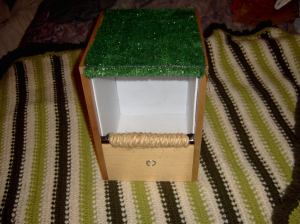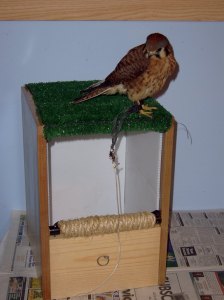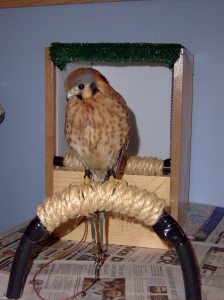I found this interesting concept for a kestrel perch/giant hood, but unfortunately it’s on blogspot and I don’t think I can repost the original post on this blog. You can find the original blog here.
Tag Archives: american kestrel
“American Kestrels in Modern Falconry”
“American Kestrels in Modern Falconry” by Matthew Mullinex is the only book that is dedicated to these tiny falcons. Often overlooked as just an apprentice bird Mullinex demonstrates that kestrels can be excellent gamehawks when flown at the proper quarry (European sparrows and starlings) and have a place in modern falconry.
 The book is pretty short at 139 pages with smallish pages and largish font. I managed to read it in two days. Still, there is more than enough here for an aspiring apprentice. Mullinex covers natural history, the historic use of kestrels in falconry, and what bird to trap (which is not necessarily straight forward when many states allow haggards in addition to passagers to be trapped), in addition to fairly standard issues found in other introductory books such as trapping, manning and training, equipment, entering, weight control, and diet. He emphasizes the importance of weight control, which may be tough for a first-year apprentice. Kestrels have a flying window of 2-3 grams, and often within 1 gram. In order to achieve that kind of control is is necessary to weigh the bird twice or more a day and feed it small portions twice or three times a day.
The book is pretty short at 139 pages with smallish pages and largish font. I managed to read it in two days. Still, there is more than enough here for an aspiring apprentice. Mullinex covers natural history, the historic use of kestrels in falconry, and what bird to trap (which is not necessarily straight forward when many states allow haggards in addition to passagers to be trapped), in addition to fairly standard issues found in other introductory books such as trapping, manning and training, equipment, entering, weight control, and diet. He emphasizes the importance of weight control, which may be tough for a first-year apprentice. Kestrels have a flying window of 2-3 grams, and often within 1 gram. In order to achieve that kind of control is is necessary to weigh the bird twice or more a day and feed it small portions twice or three times a day.
He also gives a substantial number of pages to different methods of hunting and accidents – important considerations when hawking these little birds. Car hawking should be a pretty obvious choice as it lends itself to the generally short flights of kestrels at their best prey. Mullinex also described pallet hawking – that is, sending a kestrel after sparrows that are hiding within stacked pallets often found around the back of stores and feed lots – and night roost hawking.
Like other introductory books, Mullinex provides appendices with an example of the first month of training and hood patterns. These can be very useful to a new apprentice. A few things I haven’t seen other places that I really like are a weight control and behavior chart, and disposition tables, which illustrates that kestrels are not lost or killed more than red-tailed hawks in falconry.
The book is peppered with photographs (b&w unfortunately) and line drawings. One I particularly enjoy is a still-life, “Kestrel Fare”, because it plays upon the classic paintings of the game larder.
All-in-all, the book makes me confident that I could fly a kestrel. It’s well-written and worth buying, especially if you don’t have another introductory-type book. For the experienced falconer there is perhaps less here to be gained as much of it is covered elsewhere, though it may convince them that the kestrel isn’t just an apprentice bird to be ignored or scoffed as a serious choice for a gamehawk.
Finally, I like how he ends the book:
“There is room to explore here. A true generalist, the American kestrel borrows at will from the falcons, accipiters, and buteos whatever is necessary to make the catch. Already falconers are training kestrels to wait-on; some using kites to raise pitch. How long can it be before balloons or dogs are added to the formula? The kestrel’s ability in a cast of two makes me wonder if three might not be the magic number for pursuit flights at quail? Imagine a group of sibling kestrels perched shoulder-to-shoulder, leaning toward the dog and a scaled quail just waiting to break. One lifetime is too short to try it all.”
That sums up the book nicely and mirrors my own attitude toward falconry.
Filed under Falconry, Literature




